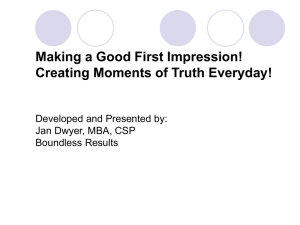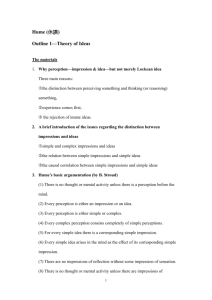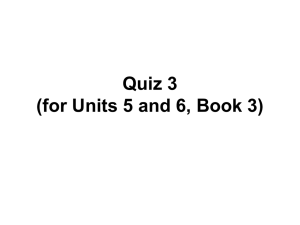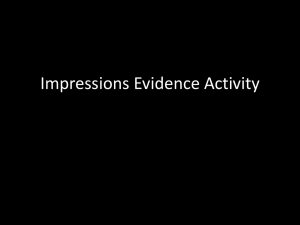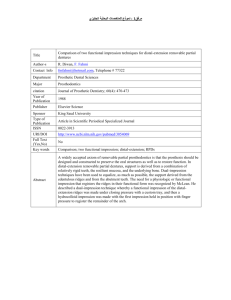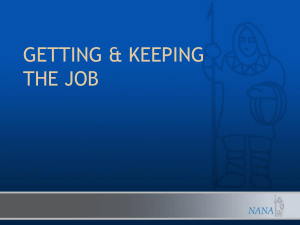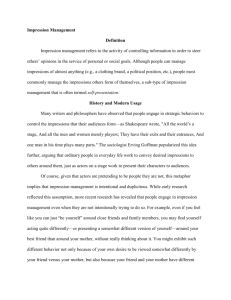Week 2: Perception Lecture Notes
advertisement
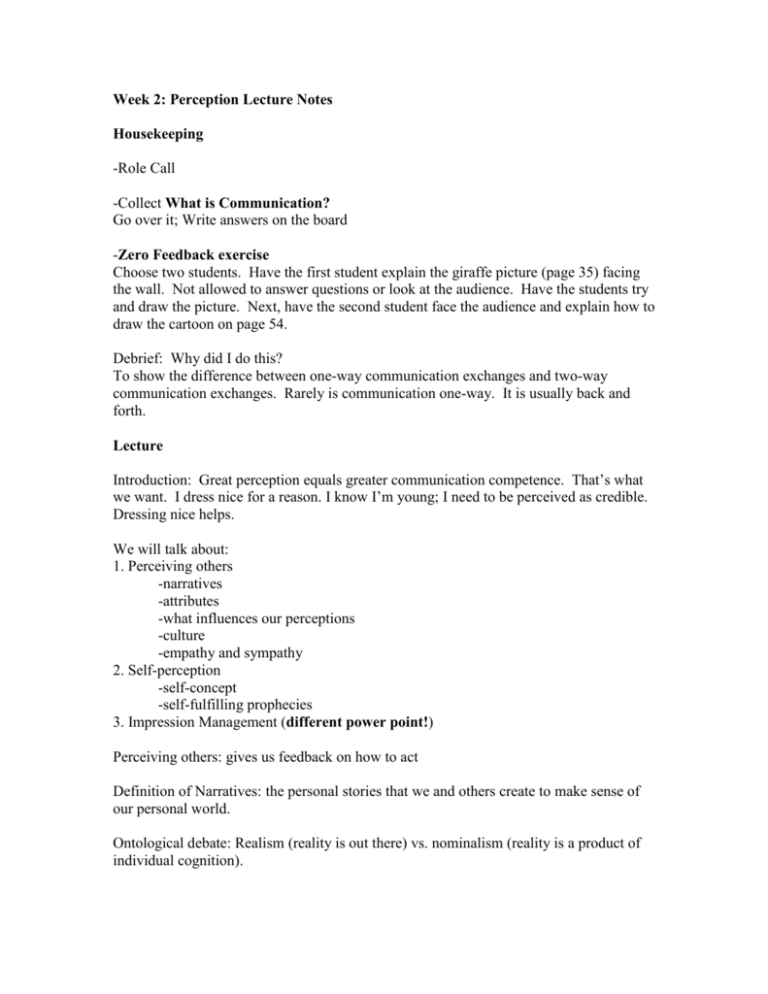
Week 2: Perception Lecture Notes Housekeeping -Role Call -Collect What is Communication? Go over it; Write answers on the board -Zero Feedback exercise Choose two students. Have the first student explain the giraffe picture (page 35) facing the wall. Not allowed to answer questions or look at the audience. Have the students try and draw the picture. Next, have the second student face the audience and explain how to draw the cartoon on page 54. Debrief: Why did I do this? To show the difference between one-way communication exchanges and two-way communication exchanges. Rarely is communication one-way. It is usually back and forth. Lecture Introduction: Great perception equals greater communication competence. That’s what we want. I dress nice for a reason. I know I’m young; I need to be perceived as credible. Dressing nice helps. We will talk about: 1. Perceiving others -narratives -attributes -what influences our perceptions -culture -empathy and sympathy 2. Self-perception -self-concept -self-fulfilling prophecies 3. Impression Management (different power point!) Perceiving others: gives us feedback on how to act Definition of Narratives: the personal stories that we and others create to make sense of our personal world. Ontological debate: Realism (reality is out there) vs. nominalism (reality is a product of individual cognition). A narrative is a shortcut. Cognition is difficult, so we want to limit it, so we use shortcuts. Example: Why is it easier to watch TV than it is to read? Why is driving difficult? We need to understand narratives because different narratives lead to communication problems. How we perceive others: 1. Self-serving bias: judging oneself more generously that one judges others example: We judge ourselves as funnier and better drivers than others. 2. We rely on ease -what is most obvious -first impressions -similarities as oneself 3. Negative over positive impressions 4. Blaming innocent victims for their misfortunes example: date rape, blaming the female vs. blaming the rapist Perception is situational: Based on: Relational satisfaction -degree of involvement -past experience -expectations (anticipations) -social roles -knowledge -self-concept Perception and Culture: Misconceptions often occur due to cultural differences. 1. Empathy: experience the world through the others perspectives, vs. sympathy: feel compassion for others, accept other pain as valid. Example: difference lies in the ability to put yourself in another’s shoes. 2. Perception checking: awareness of perceptions Perceiving the Self: Much like awareness-Proper self-perception leads to communication competence Self-concept: (how do you define yourself) a set of relatively stable perceptions that each of us hold about ourselves. Example: Who am I? Luke—Winslow—Californian—American, or American—Winslow—Luke Self-perception is influenced by: 1. Material self: You are what you have 2. Social self: part of you that interacts with others 3. Spiritual self: internal thoughts and introspection about values and moral standards. Example: Mel Gibson story/The Passion: What caused him to make this? Introspection. “I’ve been offered every kind of excess that money and fame bring and it’s not good enough. Self-esteem: evaluation of self worth. What is your value? Factors that affect self-esteem: -Gender -Social comparisons -Self-expectations Ways to enhance the self-esteem: 1. Positive self-talk -intrapersonal communication (inner speech) 2. Visualization -not just talk, but actually seeing events/actions happen 3. Reframe (put things in a new perspective) 4. Develop honest relationships 5. Lose your baggage -“Today s the first day of the rest of your life.” We study this in SPCH 100 because it is through communication that our self-concept is developed. (Refer back to last week- Communication meets our identity needs) (Stella Ting-Toomey, mentioned on page 52) Reflected appraisal: we develop an image of ourselves from the way we think others view us. Example: We all act differently around different people. The way others view us determines how we act. Story: My identity was a jock vs. identity as smart student Self-fulfilling prophecy: When a persons expectations of an outcome makes the outcome more likely to occur than would otherwise have been true. Example: power of positive thinking; 15% of doctor visits are not really sick Life’s Little Instruction Book: There’s no difference between being brave and faking it. Think about that as you give your speeches. Two Types of Self-fulfilling prophecy: 1. Your own expectations influence your behavior 2. Expectations of others govern your actions *Read from “The Illuminated Life” page 35 *Could show Heat: Robert Deniro’s perception of his self vs. Al Pacino’s selfperceptions In-Class: On a sheet of paper, write all your negative qualities on the front side (things your not good at). Write positive qualities on the back (things your good at) Homework: Make sure positive list is longer than negative list Impression Management “The communication strategies people use to influence how other’s view them. -still under the umbrella of perceptions -Why study it? It establishes perceived credibility Public vs. Private Self: Perceived self (private self): the person you believe yourself to be during self examination Example: Integrity: who you are when no one is looking Presenting self: the way we want to appear to others -socially approved self -face: presenting self -facework: verbal and nonverbal ways to maintain the socially accepted self Identity Management 1. We maintain many different identities example: student, son/daughter, friend 2. Can be conscious of unconscious example: some role we play without even thinking about it 3. People differ in their degree of identity management -awareness varies -high self-monitors vs. low self-monitors -Flexibility is the key How are impressions managed? (write on board-One cannot not make impressions) 1. Face to Face management: -manner: words and nonverbal actions -appearance: look -setting: physical items we use to influence how other view us example: lawyers are often interviewed with a bookshelf behind them. Ethics of Impression Management: Is it dishonest: No, impression management leads to flexibility which leads to communication competence. Impression Management Theory: “Seeks to explain how people go through trying to project a positive self image” (Tedeschi & Reiss, 1981) Labels impression management as persuasion (trying to increase credibility) Teens are particularity susceptible to the “looking cool” fad, especially through nonverbal behaviors. Example: walking through a restaurant Discussion How are impressions managed? What impression would you want to make during these situations? 1. Job interview 2. Night out on the town with your friends 3. Meeting your boyfriend/girlfriends parents 4. First day of college 5. Funeral Take out a sheet of paper and write down what impression you would want to make and how. Cave Activity
